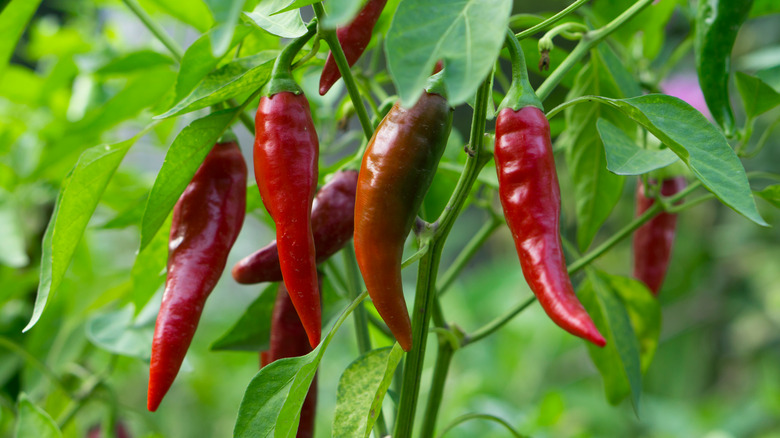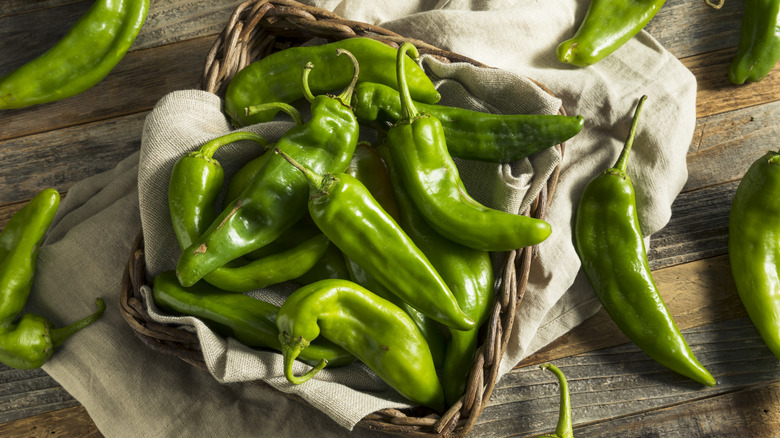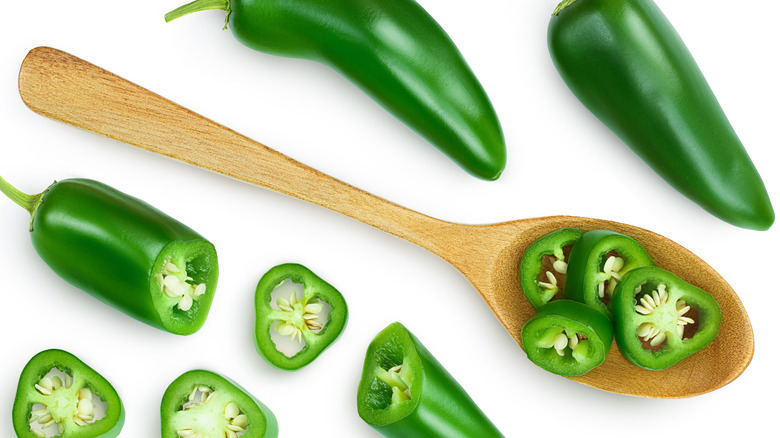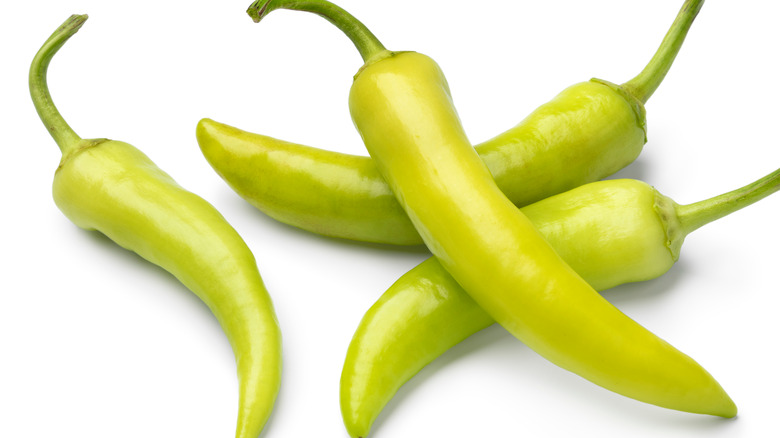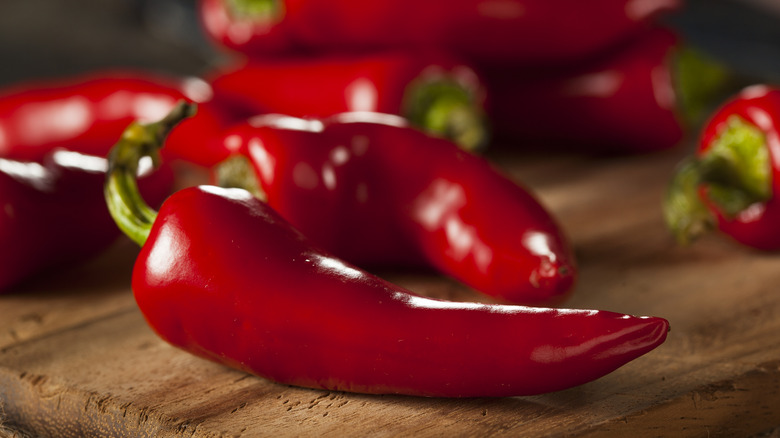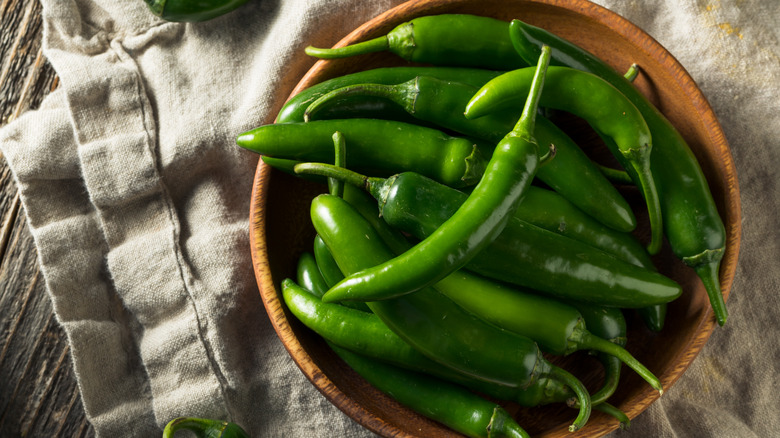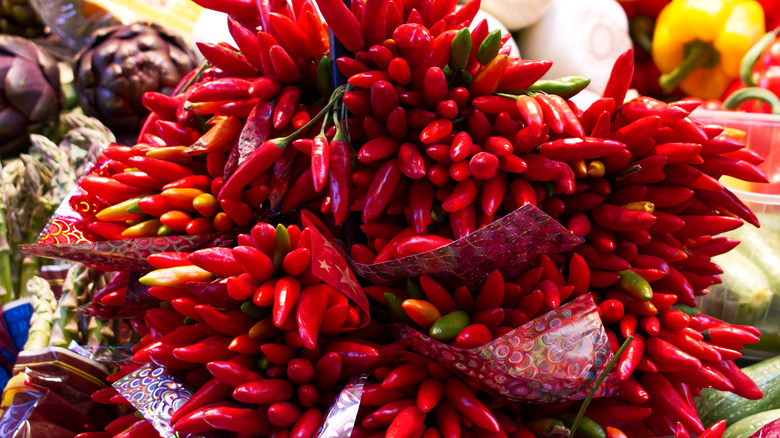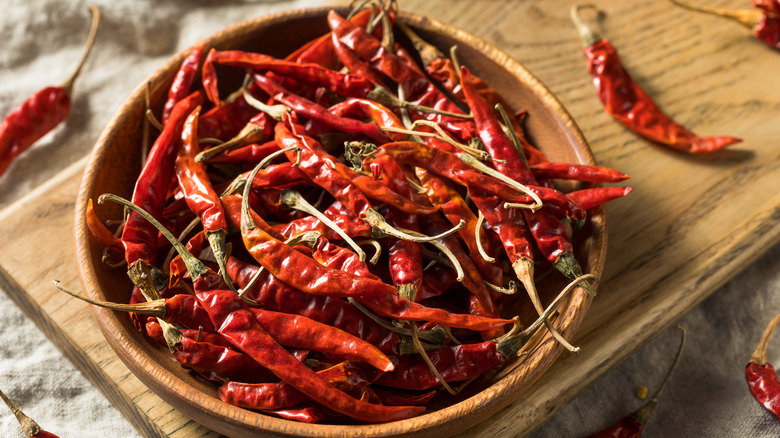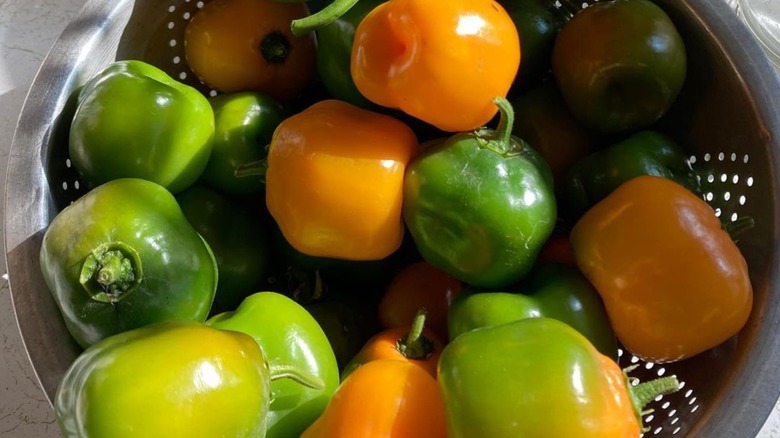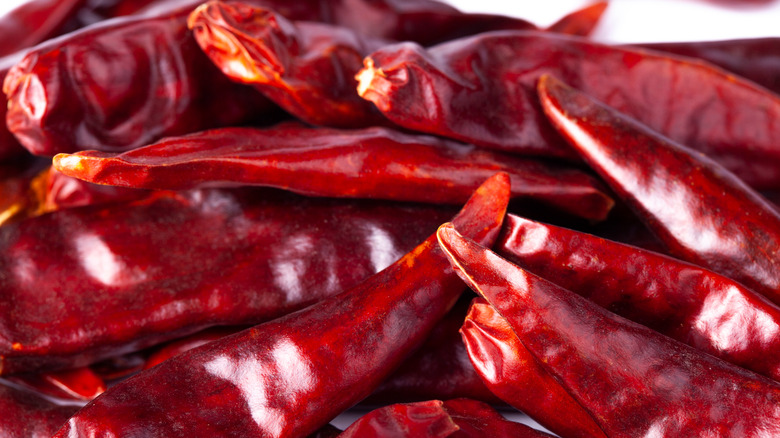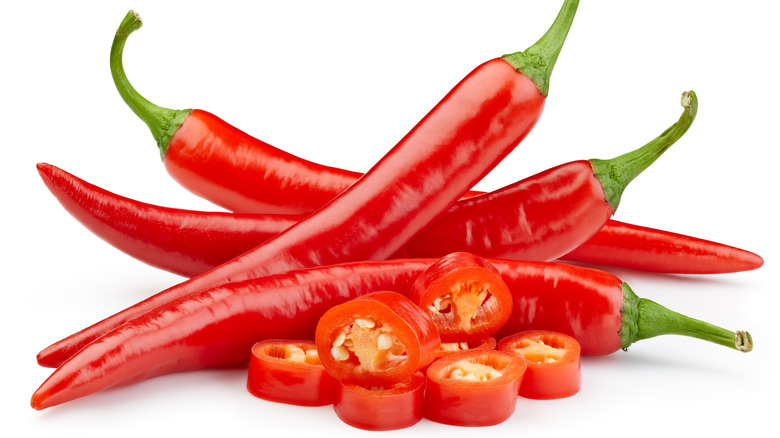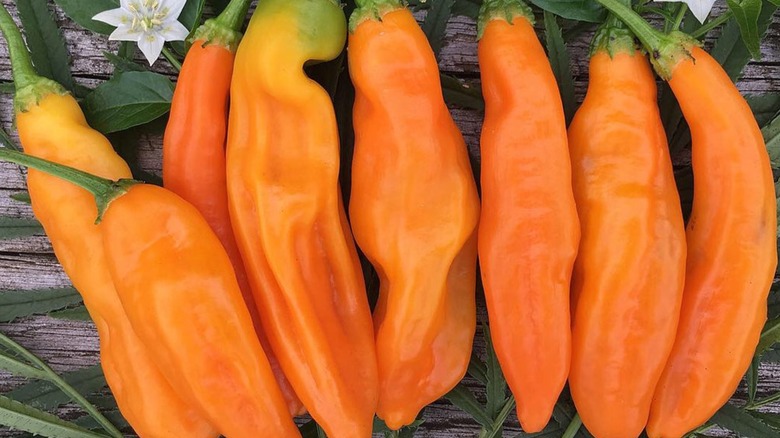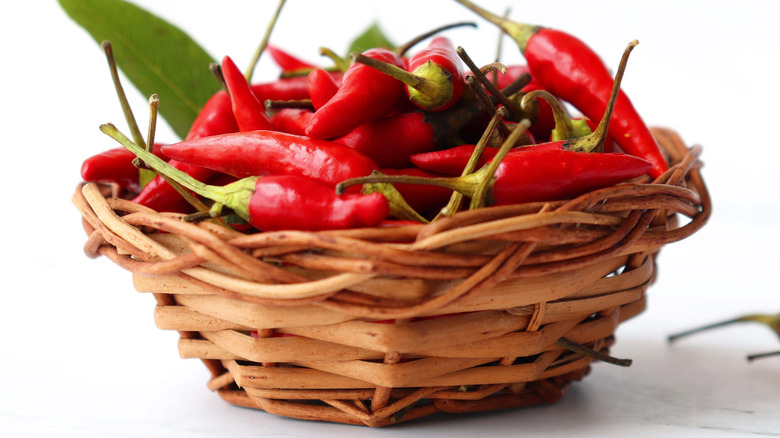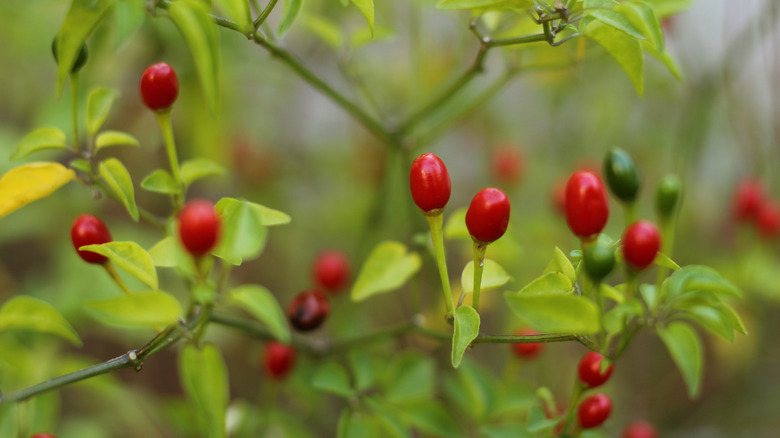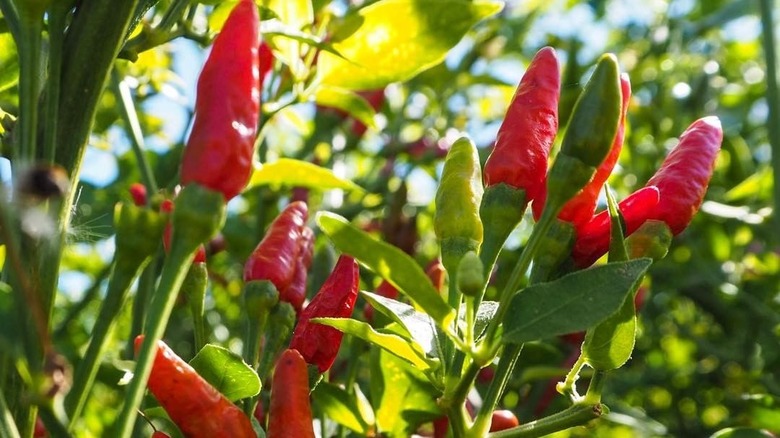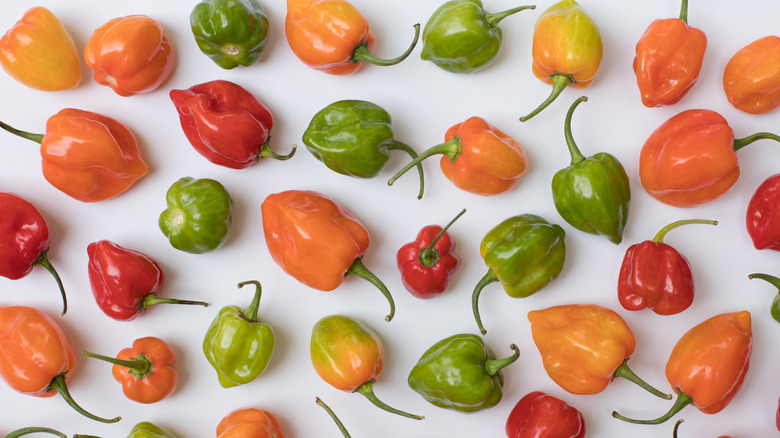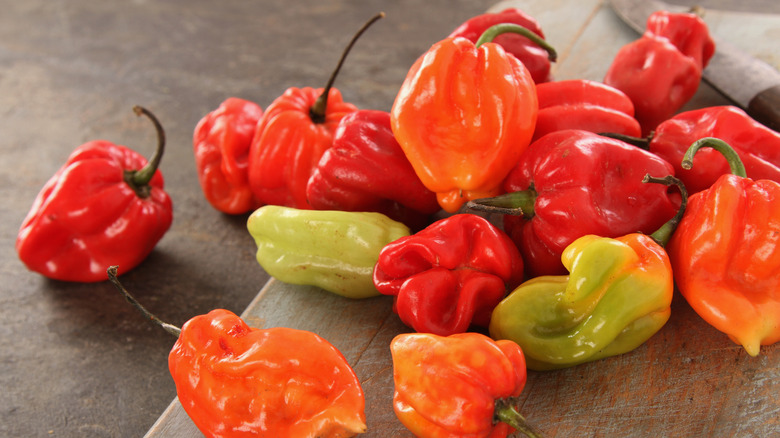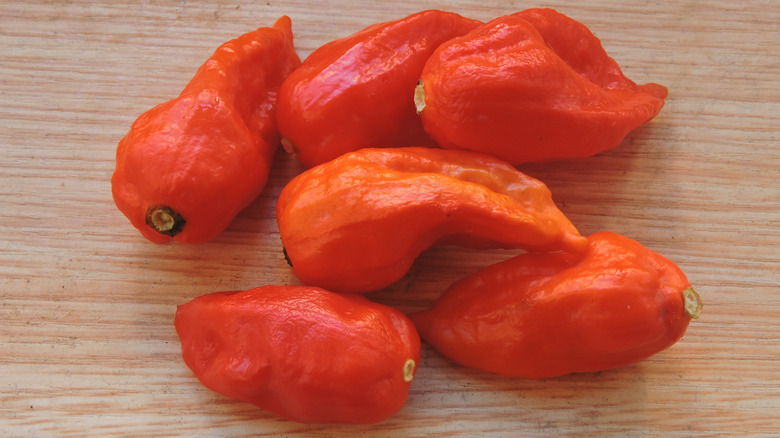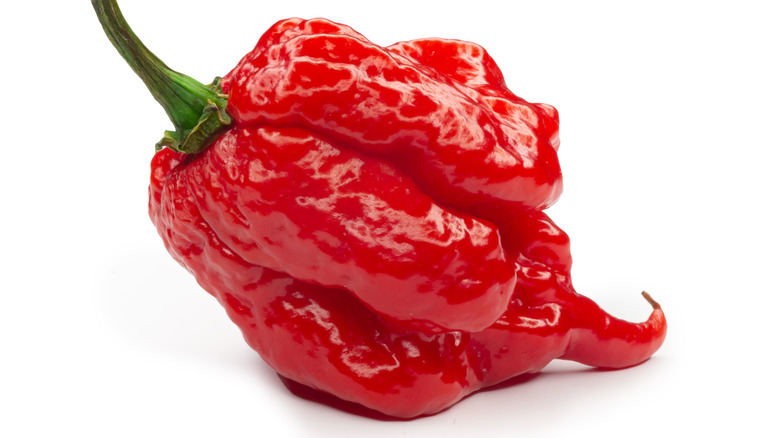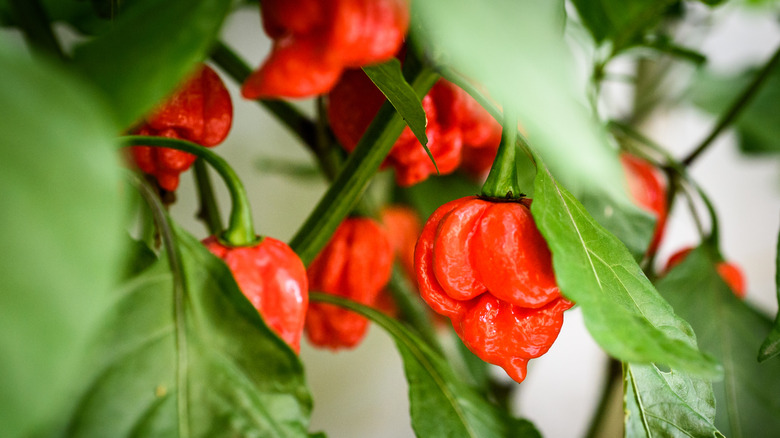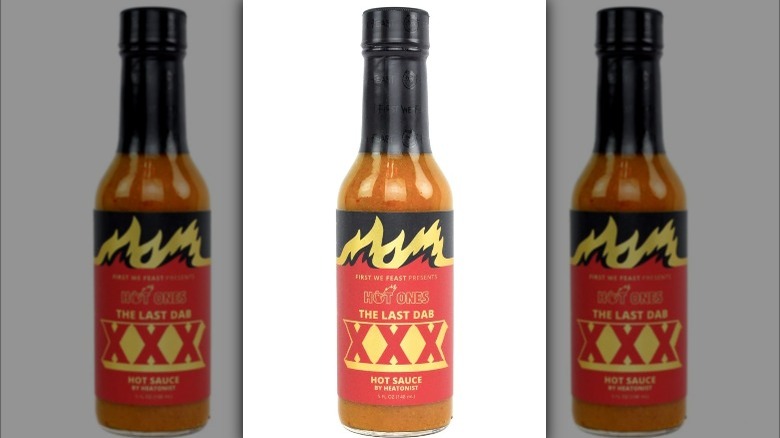20 Types Of Peppers That Will Set Your Mouth On Fire
Alimentarium says that chile peppers first appeared in South America (Bolivia, to be specific) and swiftly spread across the New World. This fruit (yes, they are a fruit) became a dietary staple across what is now Latin America and the Caribbean long before European explorers landed in that part of the world. When the Europeans arrived, they quickly spread chiles across the globe via trade and colonialism. Every place chile peppers showed up, local cooks figured out their own uses for them and bred different varieties. Now there are as many types of chiles as there are types of cuisine, if not more.
Chiles range in heat level from mild bell peppers to world-shattering Carolina reapers. Since we're focusing on spicy chiles in this list, we'll be making frequent references to the Scoville scale, which is a way to measure chile peppers' heat. This system, devised by Wilbur Scoville, initially measured how many times you had to dilute something spicy in order for it to not taste hot anymore, though now it's calculated by measuring the amount of spicy alkaloids in a substance using chromatography.
In any case, enough with the science: It's time to talk chiles. These peppers are all delicious, but they vary widely in heat level, from pleasantly tingly to ruin-your-day abrasive. They are arranged by approximate spiciness from low to high.
20. Hatch
Hatch chiles aren't known for being scorchingly hot, but there's a wide variety in heat levels between different cultivars of this New Mexican specialty. According to Chili Pepper Madness, on the lower end, Hatch chiles are only about 1,000 Scoville units, which is barely spicy at all. Hotter varieties can reach up to 8,000 Scovilles, comparable to a jalapeño, and there is anecdotal evidence that some special Hatch chiles can be even hotter than that.
Hatches are a type of New Mexico pepper. They're descended from New Mexico No. 9, a chile varietal developed by New Mexico State University researcher Fábian Garcia in 1913. They are eaten both when green (unripe) and fully ripened red. The most popular way to eat fresh Hatch chiles is to roast them, which gives them a wonderful smoky flavor. You can also buy dried red Hatch chiles, which are perfect for making Mexican specialties like enchiladas (via Hatch Chile Store).
19. Jalapeños
Jalapeños are perhaps the most famous and iconic type of hot pepper in the U.S., and according to MasterClass, they're the most popular as well. They are a member of the capsicum annuum species of chile peppers. They certainly have a bit of kick, usually registering between 2,500 and 8,000 Scoville units. However, their heat is not overwhelming compared to many of the peppers on this list, so they're a good starter chile if you're beginning to experiment with cooking with hot peppers.
Common green jalapeños have a zesty, vegetal flavor. They're picked when they're not fully ripe, so their spice level is usually somewhat subdued. As PepperScale notes, it's less common to find fully-ripe red jalapeños on store shelves in the U.S., but they're delicious, with a sweeter, fruitier flavor and more aggressive spice. This is the kind of chile that gets turned into chipotles, which are simply smoked, dried ripe jalapeños. Red jalapeños are also the main chile pepper used to make Sriracha.
18. Hungarian Wax Peppers
Don't let this chile's mellow yellow exterior fool you: This is not a mild pepper. Hungarian wax peppers aren't absurdly hot, but at 5,000-10,000 Scoville units, they're about as spicy as a jalapeño, or even a little bit hotter (via PepperScale). Like jalapeños, they come from the capsicum annuum species, although they taste quite different. Wax peppers have a zesty flavor and mild sweetness that makes them perfect for cooking with. You can also pickle them to make a spicier answer to pickled banana peppers.
But why are they called wax peppers? It's because their skin and flesh have a slightly squeaky, waxy texture (in a good way). Although they're typically sold when they are yellow-green and unripe, like most chiles, wax peppers change color as they ripen, turning bright red when fully ripe. Wax peppers are more available in American grocery stores than many other types of specialty chile, but you still may have to do a bit of hunting to find them.
17. Fresnos
Fresnos can be easily confused with jalapeños, and the two peppers are very similar. Their spice levels are almost the same, and Fresnos also share jalapeños' pointed shape. However, Fresno chiles have a distinct taste that separates them from their famous lookalike, as Eater explains.
Fresnos are relative newcomers to the chile world, tracing their origins back to Brownie Hamlin, a chile breeder who developed the pepper in the 1950s in Fresno county, California. The chile's flavor is best described as sweet and smoky, and unlike jalapeños, which are more commonly eaten green, Fresnos are best enjoyed in their red, ripe state, according to Gourmet Sleuth. That way, you get the full impact of the pepper's fruity flavor.
Fresnos aren't universally available, so if you see them at the supermarket, they're worth grabbing so you can enjoy their unique taste. You can use them any way you would use a jalapeño, including roasted, pickled, or infused in oil.
16. Serranos
Serranos look like a skinnier, pointier version of a jalapeño. Although you can find them in a variety of colors, it is by far most common to eat them in their green, unripe state. According to Chili Pepper Madness, serranos are one of the most popular chile peppers in Mexican cuisine. They were first bred in mountainous areas of the country, and their name comes from the word "sierra," which means mountain in Spanish.
Serranos taste quite similar to jalapeños, with a vegetal, grassy flavor. However, they are significantly spicier than jalapeños, registering between 10,000 and 23,000 on the Scoville scale. If you enjoy the flavor of jalapeños but crave something with a more pronounced kick, serranos are a great option. They taste wonderful when roasted, as this adds a nice smoky dimension to their flavor, but they also provide zip and heat to dishes when used raw or sautéed.
15. Calabrian Chiles
Italian food isn't necessarily known for lighting up your tongue with spice, but there is one notable exception: Calabrian chiles. It's not strictly correct to say there is one chile pepper called a "Calabrian chile." Rather, the name is applied to any kind of chile pepper grown and eaten in Italy's Calabria region. According to Nonna Box, there are four main types of chile peppers associated with Calabria: peperone dolce, naso di cane, sigaretta, and Italian Cayenne. Peperone dolce are sweet, with very little heat, while naso de cane can be mild or spicy. Sigaretta and Italian Cayenne peppers are both quite hot.
While Calabrian chiles can be and are eaten fresh, it's also quite popular to preserve them by drying, pickling, or packing in olive oil. They make a great chile oil too and can be used for our Calabrian chile honey recipe. They have a deep, nuanced flavor, with notes of smoke, fruit, and umami. You may find them labeled as peperoncini, not to be confused with pepperoncini, the pickled green peppers you'll find on Italian subs.
14. Árbol
Chiles de árbol are small, skinny chiles that are very popular in Mexican cuisine. They are almost always ripened to a dark red and dried before using, per MasterClass. They taste earthy and nutty, and they have a significant amount of heat. Árbols generally deliver about 15,000-30,000 Scoville heat units. Toasting dried chiles before using them is generally a good idea, and it definitely makes árbols taste better, as it accentuates their smoky flavor.
One way to use dried árbols is to toast them and then grind them into chile powder. This will taste much more fresh and delicious than any chile powder you can buy in a store. After toasting, árbols can also be combined with liquid and pureed to make salsas and marinades. These chiles' deep red flavor produces beautiful, brightly-colored sauces. You can also combine them with sugar and fruit, as in our recipe for plum jam with chile de arbol and thyme.
13. Manzano
According to Collins Dictionary, "manzana" is the Spanish word for apple. These peppers really do look like small apples, with their rounded shape and golden skin. You wouldn't want to bite into one like an apple, however, as they're seriously spicy: up to 30,000 Scovilles, or more than three times as hot as a particularly spicy jalapeño (via Specialty Produce). As you might expect from the name, there is a sweet, fruity flavor hiding under the heat, though it's more citrusy than apple-y.
Manzano peppers aren't terribly common in the U.S. They're from the capsicum pubescens species of chile, and they originated in South America. Specifically, they thrive in the Andes mountains, as they prefer a colder growing environment than most types of chile pepper. They may be one of the most ancient pepper varieties still grown commercially. Manzanos taste great in many applications, but one way to use them that takes advantage of their bulbous shape is to stuff them.
12. Facing Heaven
Facing heaven chiles are so-named because of how they grow. As Growstuff explains, unlike most fruits and other types of chiles that follow gravity and hang downward from the plant, facing heaven chiles grow up. Thus, the fruits "face heaven" as they mature. They are spicy, but not obnoxiously so, clocking in between 10,000-50,000 Scovilles, a little bit spicier than serranos. Unlike serranos, facing heaven chiles are typically allowed to ripen until fully red and then dried before using.
Facing heaven are one of the most common chile peppers in Sichuan cuisine, according to Mala Market. Sichuan food tends to be very spicy, so cooks there use a large number of these peppers in each dish. These peppers are grown in China's Guizhou province, which is next to Sichuan and has more favorable conditions for agriculture. You may have trouble finding these in an average American supermarket, but they're easy to source online or in Asian markets.
11. Cayenne
If you've only encountered Cayenne pepper in its dried, powdered form, it might surprise you to find out that the stuff in your spice jar actually comes from a specific type of fresh chile. According to Chile Pepper Madness, Cayenne peppers are named after the city of the same name in French Guiana, a region of South America that's ruled by France. Although they're one of the most popular chile peppers in supermarkets, it's rare to find Cayennes in their whole form in America, where they're most frequently dried and used as a spice. Most brands of chile flakes are also made from Cayenne peppers. They're a popular ingredient in hot sauces as well.
As you might expect if you have experience cooking with dried Cayenne, the fresh chiles are quite spicy. They're not in habañero territory, but they're comparable to a mild bird's eye chile at 30,000-50,000 Scovilles. They are typically used when they're red and ripe, which is when their heat is at its peak.
10. Aji Amarillo
Aji amarillo comes from the pepper species capsicum batticum. It's a bright yellow, medium-sized pepper with a pointed shape. At 30,00-50,000 Scoville units, an aji amarillo's heat level is comparable to a Cayenne. However, this pepper has a very different flavor. The Spruce Eats compares its aroma to a raisin and says that the flavor is reminiscent of tropical fruit.
Aji amarillo is the most important type of chile in Peruvian cooking. Much like the French have mirepoix and the Italians have soffritto, Peruvian cooks use their own trio of ingredients as the flavor base of numerous dishes. The Peruvian trinity is aji amarillo, red onion, and garlic.
This delicious pepper isn't super widely available in the U.S., especially in fresh form. Unless you live somewhere with a large Peruvian population, your best bet for sourcing aji amarillo is probably to look for it frozen, dried, or ground up into a jarred paste in your local Latin American market or online.
9. Bird's Eye
Bird's eye chiles are the characteristic chile pepper in the cuisine of many Southeast Asian countries, including Thailand, Malaysia, Indonesia, and Vietnam (via The Spruce Eats). In U.S. grocery stores, you'll often see them sold as Thai chiles. They're tiny, but don't let their diminutive size fool you: They pack a serious punch in the spice department. Bird's eye chiles are a scorching-hot 50,000-100,000 Scoville units, with the ripe red kind generally delivering more heat than the unripe green ones. Their heat takes a while to bloom in the mouth, starting relatively mild and then leaving you gasping for breath after a few seconds. In addition to heat, the flavor of bird's eye chiles has some mildly fruity characteristics.
Bird's eyes can be incorporated into condiments and sauces, and they're also used as a component in cooked dishes like green curries. A little goes a long way with these, but if you're into super-spicy food (and if you're reading this list, you probably are), then these chiles will be an indispensable addition to your culinary repertoire.
8. Chiltepin
Chili Pepper Madness says that chiltepin peppers are the United States' only native chile pepper species. They grow in areas along the U.S.-Mexico border. The domesticated version of chiltepins is called chile piquin.
Chiltepins are best described as small but mighty. They grow as tiny globes less than half an inch wide, but they are extremely hot. They average around 100,000 Scovilles, but there is a lot of variance in the heat levels of individual chiltepin chiles. One study in the Journal of Chemistry found a chiltepin pepper that measured over 1.5 million Scoville units, about the same as a Carolina reaper.
The heat from chiltepins comes on strong and dies out quickly, which is kind of a fun sensation. They are most commonly sun-dried when fully ripe and then used in recipes, but they can also be eaten fresh. When still green, chiltepins are sometimes used to make a pickled condiment.
7. Piri Piri
African bird's eye chiles, also called piri piri, are a variety of the capsicum frutescens species. As you might expect from the name, they look very similar to Asian bird's eye chiles, but according to Caribbean Garden Seed, they can be a fair bit hotter, maxing out at 150,000 on the Scoville scale. These chile peppers have grown wild in Africa since the Portuguese brought them over from South America, where chile peppers originated (via Thrillist).
The most famous application of piri piri peppers is a type of hot sauce, also conveniently known as piri piri. This sauce blends the chiles with citrus, bay leaves, oil, garlic, and sometimes other herbs and spices. Every restaurant makes its own version. It's a Southern African and Portuguese specialty but now shows up worldwide, usually at restaurants that serve roasted chicken. However, piri piri sauce is a great all-purpose condiment that tastes just as good on vegetables or seafood as it does on chicken.
6. Habañero
Habañeros were once considered the hottest chile on earth, but selective breeding by pepperheads has created many hotter chiles, according to PepperScale. Nevertheless, habañeros are no joke, and they're more than spicy enough for all but the most extreme heat lovers. In fact, unless diluted with other ingredients, habañeros may be unpalatably hot for the majority of eaters.
Habañeros grow in a veritable rainbow of colors, with each variety having a subtly different flavor and different heat levels. Most types range somewhere from 100,00-350,000 Scoville units, but certain extra-hot strains can top 400,000. They are pretty peppers, with a rounded globular shape and vibrantly pigmented skin. If you can withstand the heat enough to notice other flavor components, habañeros taste a little bit like tropical fruit. They're originally from South America, but now they're most common in Mexican cuisine, where you'll find them used in salsas and other dishes. With their inherent sweetness, habañeros work well when mixed with fruit in sweet-spicy combinations.
5. Scotch Bonnet
Scotch bonnets are easy to confuse with habañeros, as they have a similar rounded shape and also come in a wide array of colors. The similarities don't end there: Scotch bonnets have the same intense heat level as habañeros, and if you can taste it under all the heat, their flavor has a comparable fruity undertone (via The Spruce Eats). However, unlike habañeros, which are mainly grown and used in South America and Mexico, Scotch bonnets are the main pepper used in Caribbean cooking. They're mostly grown in Jamaica, and they're ubiquitous in that country and other island nations in the region. Their funny name comes from their shape, which is reminiscent of a Scottish tam o'shanter hat.
You'll find scotch bonnets most frequently in pepper sauce, which is served as a fiery condiment on the side of many Caribbean foods. It's also used as an ingredient in a variety of dishes, such as our jerk chicken recipe.
4. Ghost Pepper
The ghost pepper, also known as the bhut jolokia and naga jolokia, is an incredibly spicy pepper from the Northeastern part of India. According to The Healthy Indian Project, the bhut jolokia was certified as the hottest pepper in the world in 2007, although its reign was short-lived. It got kicked off the pedestal by the infinity chile in 2011, and several other peppers have claimed the crown since then as breeders compete to produce ever-spicier chiles. Nevertheless, ghost peppers have a level of heat that easily crosses the line from delicious to absurd. They clock in at over 1 million Scoville units, about one-half to one-fifth as strong as pepper spray. Apparently, the Indian military makes pepper grenades using bhut jolokias.
Ghost peppers are medium-sized and have a wrinkly outer skin that can be red, yellow, or orange. They're so hot that they can cause physical harm; per the New York Post, one man developed an inch-wide hole in his throat after eating a burger coated in ghost pepper-based sauce.
3. Carolina Reaper
The Carolina reaper is the current Guinness world record holder for hottest chile pepper. According to Guinness, Winthrop University testing found Carolina reapers to average out at a mind-altering 1,641,183 Scoville units. The reaper is the brainchild of pepper breeder Ed Currie, and you can buy seeds directly from his PuckerButt Pepper Company.
Reapers have a dappled outer layer with a long, spindly point extending from the end of the pepper. They're bright fire engine red, and they look as evil as their name implies. Per Cayenne Dianne, they're a hybrid between ghost peppers and red Savina habañeros. Interestingly, while the reaper may seem deadly, its creator started breeding peppers because he wanted to take advantage of the positive health effects of capsaicin. Since they're so blisteringly hot, reapers are best used as an ingredient in sauces rather than eaten straight, although you'll find plenty of YouTube videos of people eating reapers as a stunt.
2. Trinidad Moruga Scorpion
The Trinidad Moruga Scorpion is another one of the hottest peppers on Earth. In fact, according to Live Science, certain examples of this chile can be even hotter than an average Carolina reaper, reaching upwards of 2 million Scovilles. It's a variety of the capsicum chinense species of chiles, and it's a cousin to the slightly less hot Trinidad scorpion.
The Trinidad Moruga Scorpion is so hot that it overwhelms your body's usual defense against spicy food. The director of New Mexico's Chile Pepper Institute told Live Science that typically, your brain releases endorphins to diminish the pain of super-hot foods. However, Trinidad Scorpions go beyond this chemical defense and induce an actual physical reaction in your body. People who eat these peppers experience blistering on their throat and tongue. These blisters are your body's last-ditch effort to shield the cells underneath the blister from the irritants in the pepper. However, even blisters can't contain the scorpion pepper's capsaicin assault.
1. Pepper X
Although it hasn't been certified by the Chile Pepper Institute or Guinness, pepper X may very well be the hottest pepper on earth. That's what its inventor claims, anyway, according to "Today." Pepper X was developed by Ed Currie, the same man who bred the Carolina reaper, so if it officially becomes the world's hottest chile, he would just be breaking his own record (per MyRecipes, another chile, Dragon's Breath, claims to clock in at around 2.5 million Scovilles, but Guinness has not confirmed it as the world record-holder either). Currie claims that pepper X delivers an unbelievable 3.18 million Scovilles, which, if true, would make it almost double the heat level of a Carolina reaper.
Right now, you can't buy pepper X whole or in seed form, but you can get a hot sauce that uses this scorching chile as its main ingredient. As we've already reported, The Last Dab hot sauce is a collaboration between Heatonist and the web show "Hot Ones." The user reviews on Heatonist's site indicate that this sauce has great flavor in addition to the burn if you can handle it.
